You are reading the older HTML site
Positive Feedback ISSUE
13may/june 2004
Art goes to Home Entertainment 2004, Part
1
by Art Shapiro
Once again this year I had the pleasure of attending the annual high end audio show, HE2004, returning to New York City after a hiatus of two years. Well, I couldn’t lie to you and say how much I enjoy the prospect of flying cross-county. Air travel these days is traumatic under the best of circumstances. But my carcass arrived intact, miraculously enough, and I was able to keep myself busy all four days—the Press day on Thursday and the three consumer days Friday through Sunday. I saw most rooms, although I did miss several that had precisely scheduled demos requiring waiting in a line for an extended period of time. Sorry—I much prefer those rooms where one can wander in and out at will.
Having press credentials is a privilege for which I’m most grateful. Besides offering the extra relatively uncrowded Press day, it opens a few doors and presents opportunities not generally bestowed upon the hoi polloi, as well as giving a small press lounge where one can sit down for a few minutes over a muffin and would-be coffee (which would be the pride of any Mongolian army outpost) and use several broadband-connected computers. There is also one Press Luncheon, featuring relatively fancy cuisine followed by a keynote address pontificating upon each year’s flavor of "your home soon be a complete marvel of digital interconnectivity." My reaction as an gourmand: Yum. My reaction as an audiophile: Yawn. I have always been treated with genuine courtesy by the folks running these shows, and they seem as friendly and cooperative with me as they are with, say, the big name Stereophile reviewers. If any of the responsible people happen to stumble upon these ramblings, please accept my sincere thanks.
There have doubtlessly been, and will continue to be, quite a few web sites and actual publications giving neat, professional photographs of virtually every room. It seems silly of me to attempt that angle in covering the show. Instead, I’d like to share a few photos with you, of the myriad that I snapped, that I’ve selected for one or more of several reasons:
I thought these rooms offered fine sonics, often a significantly difficult prospect under show conditions;
There was something visually interesting that you readers might enjoy seeing; the sound might or might not be noteworthy but there was some aesthetic savoir faire involved;
There was an interesting story that can be associated with the picture;
The equipment happens to be something I have in my own system, and anything worthy of being in Art’s System is worthy of sharing with the readership;
The representatives offered significant under-the-table incentives for me to give them some publicity—wine, women, song, 250 wpc tube monoblocks, etc.
If you haven’t been to one of these shows before, let’s go over the logistics. Actually, let’s first say that you’re missing a lot of fun, a place to see enough good equipment in one place to satiate any audiophile, the opportunity to interact with scads of other folks with similar interests, and the privilege of casually chatting with designers, manufacturers, reviewers, and various other luminaries of the audio world. Yeah, if you’re not a local you’re talking nontrivial transportation, food, and lodging expenses. But those three or four days of audio immersion can be a great pleasure and well worth the grief.
The shows are generally held in a large metropolitan hotel, in this case the Manhattan Hilton. A few floors of the hotel are devoted to audio rooms—and home theater rooms, which this reviewer disdainfully ignores aside from cursing the obnoxiously obtrusive bass blast from those rooms that can play havoc with adjoining audio-oriented systems. Exhibits are typically put together (big $$$) by manufacturers, distributors and other middlemen, dealers, or some combination thereof. Rooms are well-marked as to the constituent equipment labels, and patrons are given a comprehensive show guide enabling them to see whatever they so desire. One traipses methodically or randomly to see and hear whatever one fancies. As I mentioned earlier, some rooms are run with precise demos of carefully selected music at set times, whereas others (most) allow patrons to wander in and out as they want, limited only by the sizeable crowds in some rooms at some times. Many rooms permit show-goers to intersperse their own CDs and LPs with those being played by the room holder. Various hallways and a large ballroom are devoted to numerous small booths and tables for silent exhibits and for the sale of various audio accessories and CDs and LPs, and that’s what I wish to present in this report. Here’s a view of one small corner of that large area:
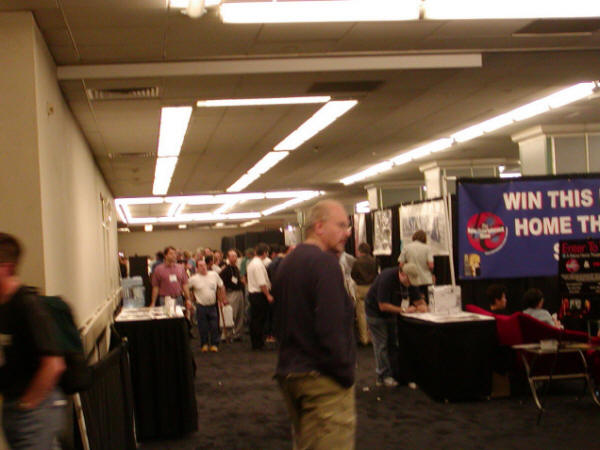
Let’s take a brief look at this area. Here in the grey/blue jacket is my fellow reviewer Mark Katz, examining the wares at the May Audio Marketing area and shelling out for the merchandise—show prices tend to be quite attractive:
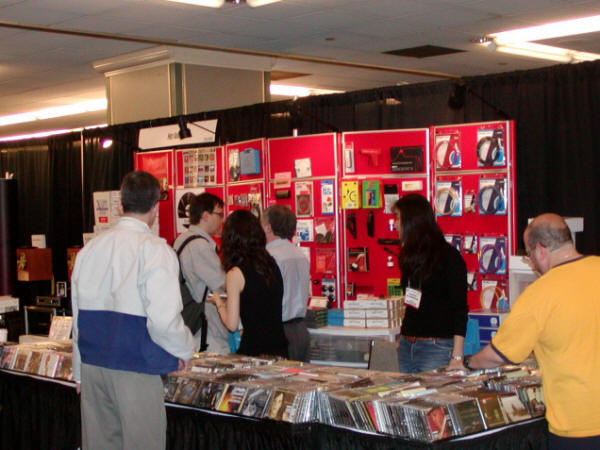
Here’s a posed shot of GutWire’s Alex Young and Herbert Wong, with Alex holding some of the NotePad resonance damping pads and Herbert showing one of the massive GutWire power cords.
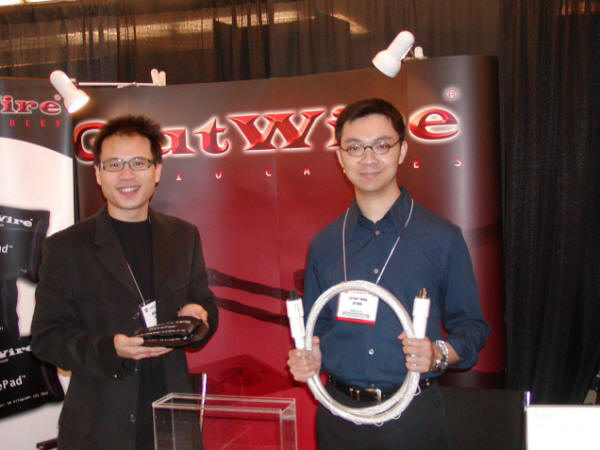
I’ve been using GutWire power cords for my big Manley monoblocks. Alex and Herbert gave me some hints on using the Note Pads in my system; I have three of them and had not observed any effect when placed on three of the four Manley transformers. They suggested that I should first try the top of my transport, so I’ll do that when finally getting back to California next week.
Also in the exhibit area were some attractive room resonance control devices from Real Traps. These folks are a competitor for better-known firms such as Echo Buster. The Real Traps are stiff, 12 pound slabs that can be wall-mounted or held by floor stands:
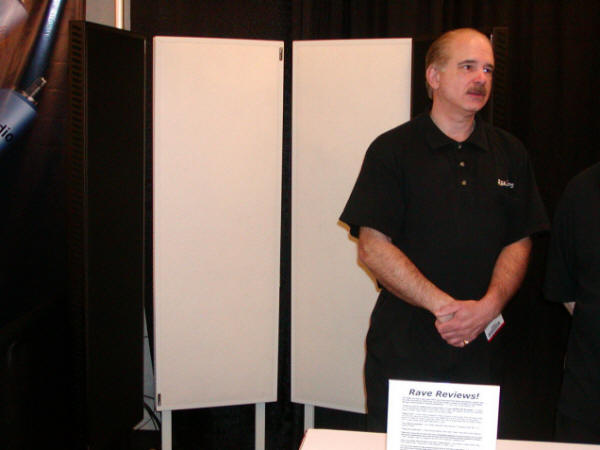
Another interesting vendor in this room was Soundations, manufacturer of a quite extensive line of audio racks:
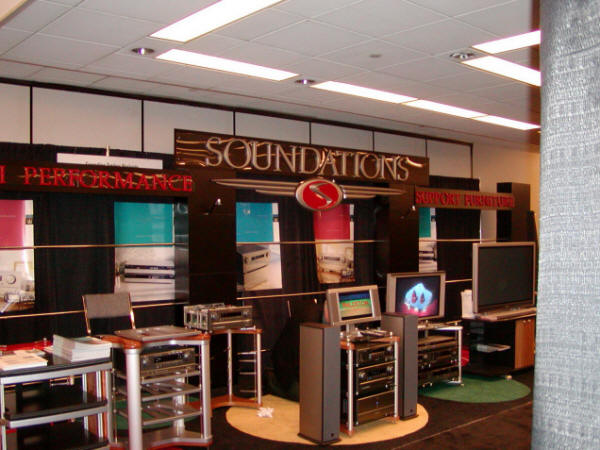
Having turned into somewhat of a "color orange freak" in recent years, I was quite visually attracted to the back left rack in that picture, using swinging fingers to support components of various sizes:
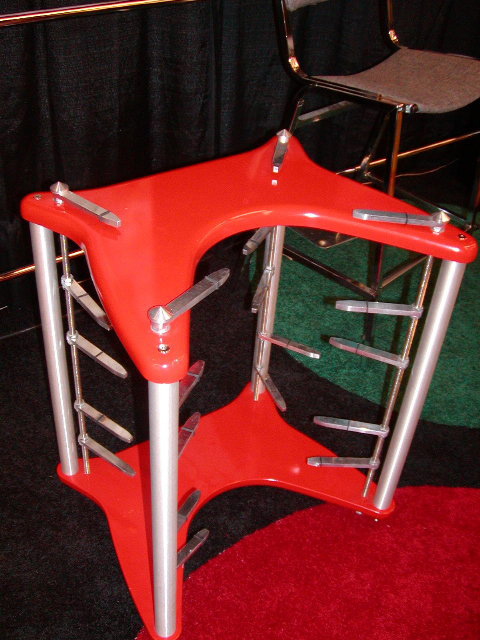
Several of the racks featured isolation shelves using various methodologies. If you look closely at the following picture, you’ll note some of the several coil springs used to isolate each shelf:
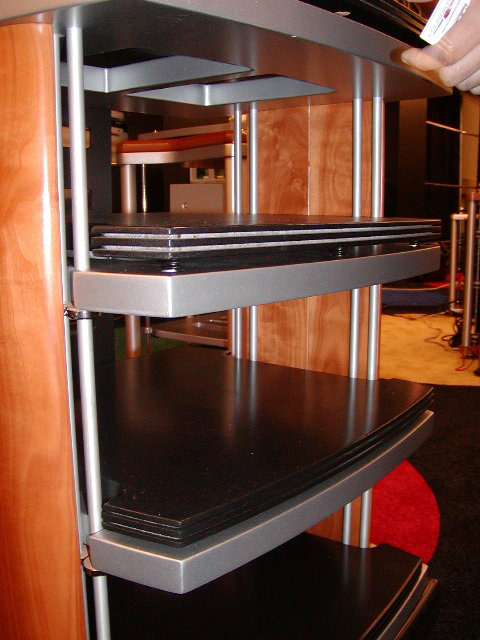
Another model in the Soundation line suspended each shelf by multiple elastic loops from the rack framework.
Of particular personal interest was my first real-life encounter with the Symposium line of isolation platforms and devices. My personal friend and EnjoytheMusic reviewer Rick Becker has written at length about the Symposium shelves and Rollerblock isolation devices. Hey, just because it’s a good photograph, here’s Rick himself, with whom I had the pleasure of enjoying a nice dinner at a nearby restaurant:
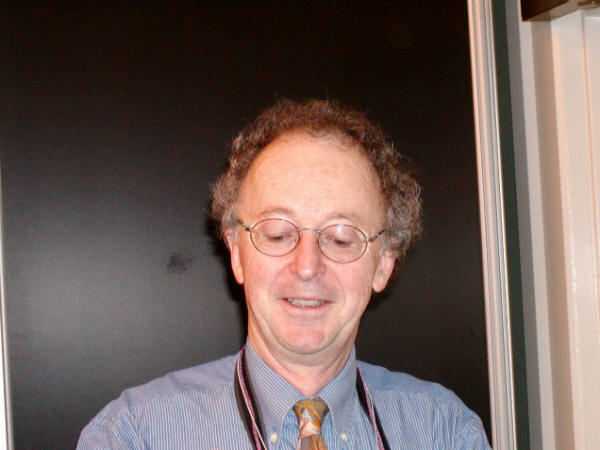
And here is Symposium’s Peter Biziewicz with some of his product line:
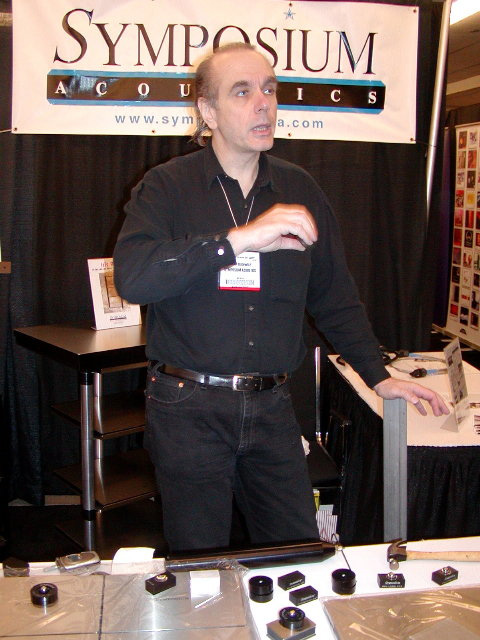
Peter spoke at considerable length about his philosophy of vibration control, and had some frankly startling demos which spoke well for the effectiveness of his products. Here’s a shot of one of his constrained-layer damping platforms, with a couple of Rollerblocks on top:
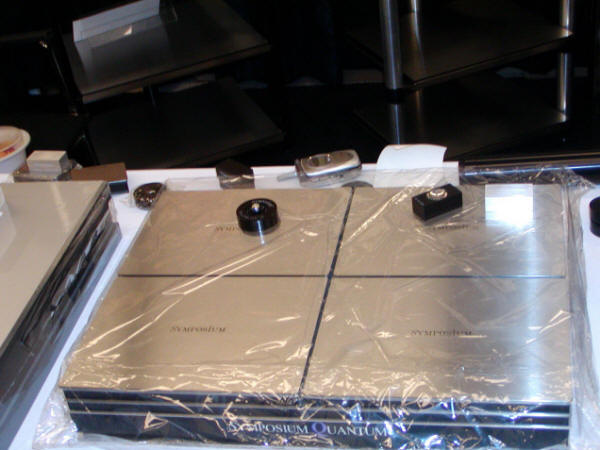
There are always a smattering of non-audio vendors in the display area, and this year was no exception. One interesting booth was showing speech recognition software used to control a word processor and to enter text. The gentleman running the "Voice Factor" exhibit was speaking through a headset/boom mike combination, telling the word processor to move down 3 lines, enter text, save, etc. It was quite impressive seeing the laptop’s image projected on a screen as it followed his commands.
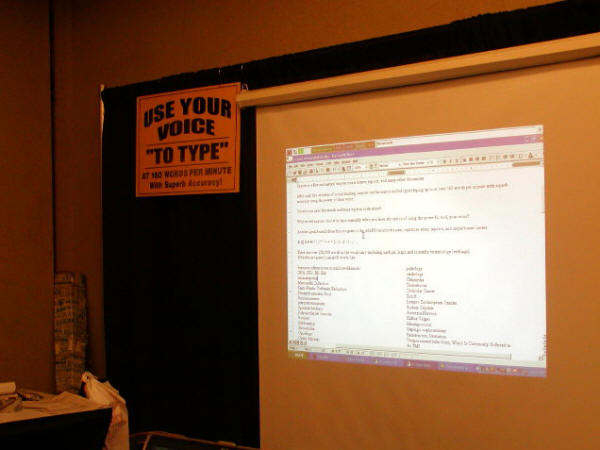
Seeing my interest, he asked me to try and baffle it, so I told him to make it type "onomatopoeia". Needless to say, it mangled it, changing the word into some three or four word phrase that made no sense. But he asked me how to spell the word, and as I recited "o n o m" he typed into an inbuilt dictionary which quickly revealed the correct word. He highlighted the word, and orally instructed the program to learn it, reciting the word a couple of times:
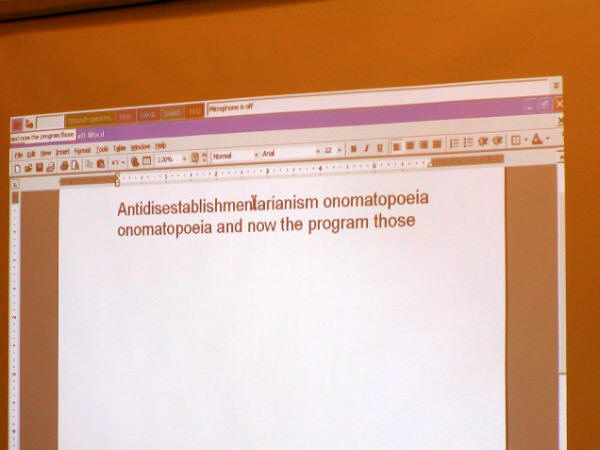
And thereafter, the program knew the word and got it correct. Quite impressive!
This is getting fairly long, considering it will be submitted via a dial-up connection, so let’s put report #1 to bed. We’ll start looking at some of the actual system rooms in the next report. Over and out.
